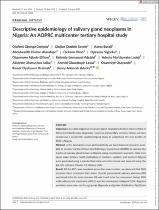| dc.description.abstract | Abstract Objectives: Accurate diagnosis of salivary gland neoplasms (SGN) in many centers in Africa is limited by poor diagnostic resources and ancillary services. Hence, we have carried out a multicenter epidemiological study to understand the true burden of SGN in Nigeria. Method: In this descriptive cross‐sectional study, we have deployed resources avail‐able to members of the African Oral Pathology Consortium (AOPRC) to examine the burden of salivary gland lesions in Nigeria, using a multicenter approach. Data from seven major tertiary health institutions in northern, western, and southern Nigeria were generated using a standardized data extraction format and analyzed using the Epi‐info software (Version 7.0, Atlanta, USA).Result: Of the 497 cases examined across the seven centers, we observed that SGN occurred more in females than males. Overall, pleomorphic salivary adenoma (PA) was found to be the most common. PA was found to be the commonest benign SGN while adenocystic carcinoma (ADCC) was the commonest malignant SGN. | en_US |

